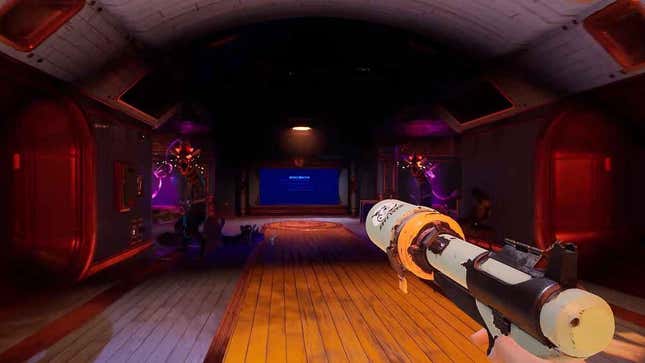Judas Previews Highlight BioShock Successor’s ‘Narrative LEGOs’
It’s been just over a decade since BioShock series creator Ken Levine closed down Irrational Games to form “a smaller, more entrepreneurial endeavor” that would become Ghost Story Games. The studio’s first project, Judas, has been in the works for ten years as well, and after a few trailers teasing the BioShock spiritual successor, the first previews have come out. To no one’s surprise, the game continues to sound a lot like BioShock, with the addition of so-called “narrative LEGOs,” an ambitious idea that still sounds unclear in its execution. In particular, a special preview by IGN has shed new light on how Judas is shaping up.
IGN’s Ryan McCaffrey, along with Game Awards host Geoff Keighley, had the opportunity to spend six hours playing a build of Judas and then sit down for a lengthy interview with Ken Levine. (Keighley also posted his own impressions of the preview on The Game Awards’ YouTube channel.) As past trailers have shown, the game follows the titular Judas as she attempts to navigate three factions vying for power aboard the Mayflower, a colony ship shepherding humanity to Proxima Centauri. Gameplay incorporates elements familiar from BioShock. As Keighley says in his video, “there’s hand powers, there’s hacking.” There’s also mention of roguelite elements, but neither IGN nor Keighley fully dive into that, opting instead to preserve the surprise for players. The main focus of the previews are the narrative LEGOs that Levine first talked about in a 2014 GDC talk.
So, what exactly are narrative LEGOs anyway? “The metaphor is basically like LEGO, it’s you’ve got a bunch of these pre-crafted bricks and they’re really well designed and the bricks know how to communicate with each other,” Levine tells IGN. “You build all these smaller piece elements in the game and then you teach the game how to make good levels essentially, and good story, and most importantly, reactive to what you do.” As detailed in IGN and Keighley’s previews, the main way players interact with the narrative LEGOs in Judas is through the three main NPC characters.
These are Tom, Nefertiti, and Hope. The three each have their own goal for the Mayflower, and want to use Judas as a means to an end. Tom wants to preserve life aboard the ship, Nefertiti wants to create a fully robotic civilization without human flaws, and Hope just wants you to help delete her to end her suffering. “It’s up to you to side with whomever you feel like, but whatever choice you make has consequences,” writes IGN. “Doing a favor for Tom might piss off Hope and/or Nefertiti, and vice versa.”
Levine further describes the system as a non-linear experience that lets players encounter new situations from playthrough to playthrough. The three main NPCs can appear as a hologram to Judas at any time, aiding or hindering her based on their relationship, and will often have discussions with you and each other based on your choices up to that point. The semi-procedurally generated nature of the narrative extends to the structure of the Mayflower, which Levine notes will be different every time you die and come back.

Yet, even after six hours of hands-on time, neither IGN nor Keighley are able to make clear exactly how these lofty promises of the narrative LEGOs actually pay off. That could be because six hours is still a relatively small slice that may not really illuminate how those narrative building blocks work.
It also feels like the idea of narrative LEGOs might suffer from being attached to a game that’s been in development for a decade. In that time, games like 2014’s Middle-Earth: Shadow of Mordor (and its Nemesis system), Baldur’s Gate 3, and Dragon’s Dogma 2 have given players access to extensive game narratives that offer multiple paths the player can go down, with their respective worlds and characters reacting in detailed ways. A decade ago, Judas’s narrative LEGOs may have seemed like a bold idea for the future of gaming, but in 2024, with the game’s release date still nowhere in sight, they’ve got a lot more to prove.


